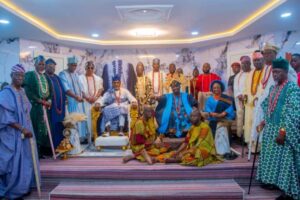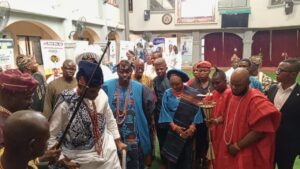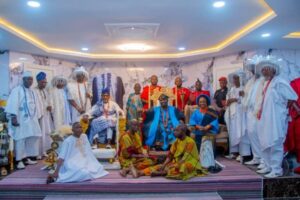![]()
The newly installed Alaafin of Oyo, His Imperial Majesty Oba Abimbola Akeem Owoade I, on Wednesday, paid a royal visit to the Olowu of Owu Kingdom, His Royal Majesty Oba (Prof.) Saka Adelola Matemilola, in a significant show of Yoruba royal solidarity.
The visit, which took place at the Owu Palace in Abeokuta, was marked by pomp, tradition, and a deep sense of cultural pride, as both monarchs reaffirmed their shared commitment to the unity and progress of the Yoruba race.
Addressing the gathering, Oba Matemilola stressed the importance of love, peace, and cooperation among traditional rulers across Yorubaland.
“We are the pillars of our respective communities and of the larger society. It is important that we maintain peace and unity among ourselves to foster the progress of our people,” the Olowu said.
Welcoming the Alaafin to Abeokuta, Oba Matemilola described the visit as a continuation of the long-standing historical bond between the Owu and Oyo kingdoms.
He noted that the enduring friendship between the two royal houses should be preserved and strengthened for future generations.
In his remarks, Oba Owoade commended the Olowu for his warm reception and pledged continued collaboration between both palaces to promote Yoruba culture and heritage.
The Olowu also seized the moment to formally invite the Alaafin to the upcoming Odun Omo Olowu Festival, slated for October.
The annual festival brings together sons and daughters of the Owu Kingdom from across the globe in a celebration of identity, unity, and cultural heritage.
The Alaafin was welcomed with rich displays of Yoruba culture, including traditional drum performances, dance, and renditions of the Owu Anthem.
Certainly, Crown. Below is the extracted portion about Chief Abiodun Lasile from the article, presented as a standalone segment:
Also speaking at the event, the Orunto Baalufe of Owu Kingdom, Chief Abiodun Lasile, who served as the compere and took the audience through a detailed narration of the historical origins of the Owu people and their deep-rooted ties with the Oyo Kingdom.
Chief Lasile traced the lineage of Ajibosin, the first crowned king among the children of Oduduwa, describing Owu as the “firstborn” of the Yoruba kingdoms hence the popular saying, “Owu ni a koko da.”
“The Olowu Ajibosin and his six companions form the nucleus and foundation of Owu people all over the world. Owu was not just the first, but it stood at the center of early Yoruba civilization,” Lasile explained.
He further recounted that Oduduwa, regarded as the progenitor of the Yoruba people, was succeeded by his son-in-law Obatala, who married Iyunade, Oduduwa’s first daughter, and through whom Ajibosin was born.
Delving into the Owu expansion era, Chief Lasile noted that the Owu people grew in strength and prominence around the Empe region near old Oyo, ruling over vast areas and even collecting tributes from the Bariba and Borgu tribes until the reign of Sango.
He cited oral traditions identifying Owu Orile, located about ten miles from Awe, as the ancestral homeland of the Owu people.
On the migration history, Chief Lasile highlighted the peaceful settlement of the Owu people in pre-1820 Ibadan, after receiving friendly overtures from Ibadan leaders who sought to avoid conflict.
“Owu didn’t go to war with Ibadan; instead, they were invited to settle peacefully from Ita Lisa to what later became Owu Ipole. This reflects the character of Owu diplomatic, respected, and strategic,” he said.
Meanwhile, the palace courtyard came alive with vibrant colors and deep-rooted customs that reflected the significance of the royal engagement.
Kings, high chiefs, dignitaries, and cultural stakeholders joined the Olowu in receiving the Alaafin, adding grandeur and pride to the event.

























